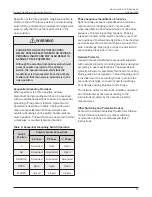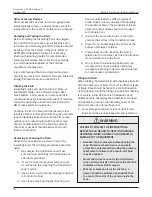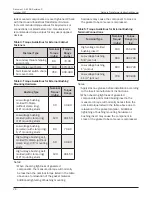
Document 2.4.128, Revision 3
October, 2017
23
Network Transformer Instruction Manual
1. Insulation Resistance Test. Refer to “
Insulation
Resistance Test
” for instructions.
2. Turns Ratio Test. Refer to
“Ratio Test”
for
instructions.
3. Insulation Power Factor Test (This test cannot be
performed on a transformer having a secondary
neutral that is solidly grounded.)
4. Fluid quality tests, such as moisture content,
power factor, dielectric strength and dissolved
gas analysis.
Exterior Paint Finish
Any damage to the exterior paint finish that exposes
the primer coat or bare metal should be repaired
immediately in order to prevent corrosion. Areas to
be repaired should be clean and dry. The surface
should be sanded to remove rust, loose paint
flakes and other debris. The surface should then be
cleaned with a suitable solvent to remove any oil,
grease or other contaminants. At lease two coats
of high-quality touchup paint should be applied to
the damaged area. Touch-up paint is available in
aerosol cans from the Howard Industries Transformer
Division.
Fluid Leaks
Check the tank for indication of fluid leaks, looking
carefully at weld seams and at tank fittings, such as
bushings, gauges, plugs and valves. In addition to
the presence of fluid residue, a low reading on the
fluid level gauge is further indication of a possible
fluid leak. Fluid leaks should be repaired as soon as
possible to prevent moisture contamination of the
insulating fluid and to prevent internal flashover due
to low fluid level.
WARNING
FAILURE TO FOLLOW THE INSTRUCTIONS
BELOW COULD RESULT IN DEATH OR SERIOUS
PERSONAL INJURY AND MAY ALSO RESULT IN
DAMAGE TO THE EQUIPMENT.
• Do not energize the transformer if the fluid
level is low.
• Maintain proper fluid level while the
transformer is energized.
If a fluid leak is suspected, investigate thoroughly
to determine if an actual leak does exist on the
transformer. False indications of a leak can occur
as a result of residual fluid that was not sufficiently
cleaned during the oil-filling process. In some cases
silicone lubricant used to install high-voltage bushing
inserts can spread to the tank surface, giving a false
indication of a fluid leak.
To verify that a fluid leak exists, clean the suspected
leak area with an appropriate solvent to completely
remove the fluid and observe the area for
reappearance of fluid. Pressurize the tank with dry
air or dry nitrogen through the pressure test fitting
to a pressure of 3-4 PSIG. Let the tank stand under
pressure for one to two hours, then examine the tank
and fittings for leaks. Leaks above the fluid level can
be detected by applying soap solution to all welds,
joints, pipe fittings, and cable connections.
In many cases a small pin-hole tank leak or leak
from a bushing, gauge, valve or other fitting can be
repaired on site. Pin-hole and weld seam leaks can
usually be repaired by welding on a de-energized
transformer.
Bushing leaks can sometimes be corrected by
tightening the bushing clamp bolts. Do not exceed
the recommended torque values listed in Table 4 to
prevent the possibility of bushing or gasket damage.
Audible Sound Level
It is normal for transformers to emit an audible
humming sound, which is primarily caused by
alternating magnetic flux in the transformer core.
Amplitude and harmonic content of the sound is
influenced by transformer size, the energizing voltage
level and sinusoidal purity, load conditions and
acoustic conditions at the installation site. Unusual
sounds should be investigated, as this might indicate
a potential problem.
Refer to NEMA Standards Publication TR-1,
Transformers, Regulators and Reactors
, and IEEE
Standard C57.12.90,
IEEE Standard Test Code for
Liquid-Immersed Distribution, Power, and Regulating
Transformers
, for more information about design
sound levels and factory sound testing.






































